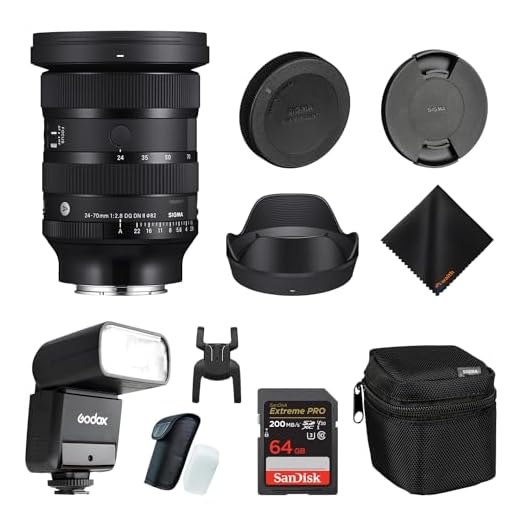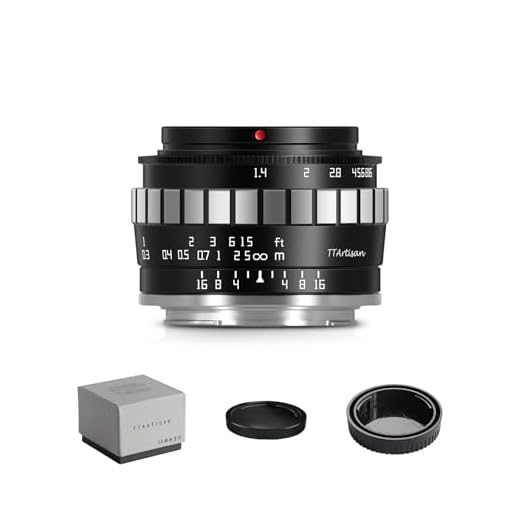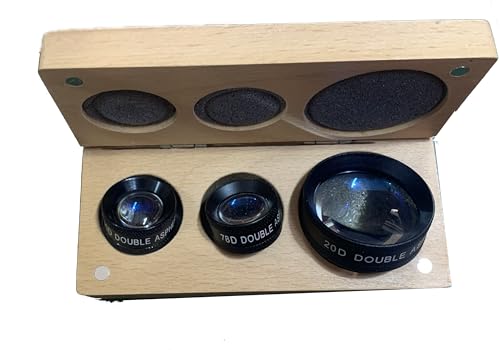
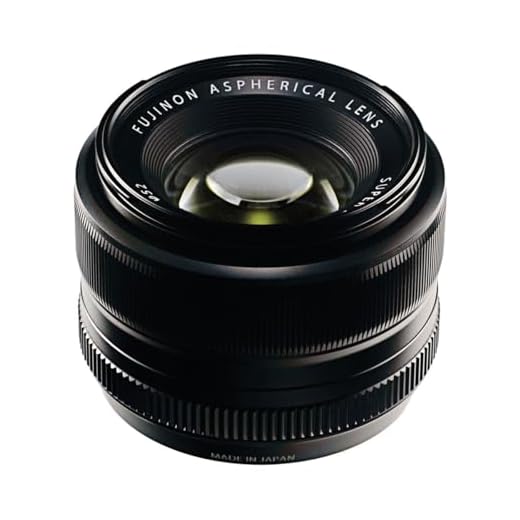
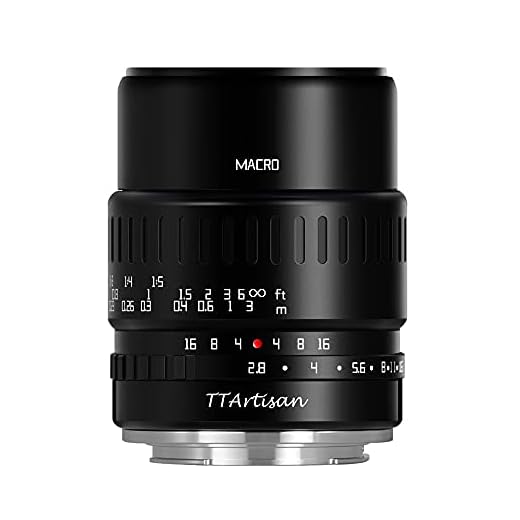
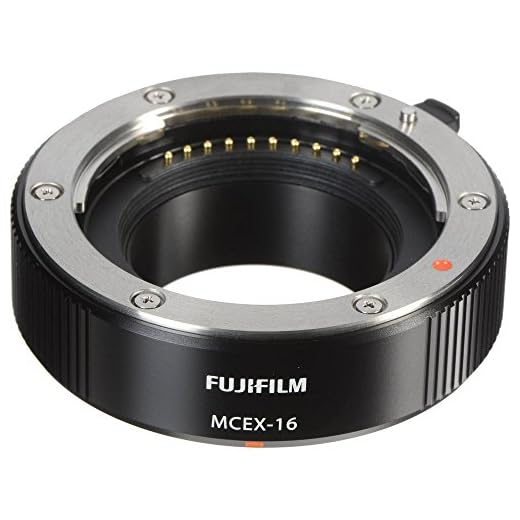
If you’re aiming for versatility and performance, I highly recommend exploring the XF and XC series from Fujifilm. These high-quality optics are designed specifically for their APS-C format, ensuring excellent image quality and autofocus speed. The XF 18-55mm f/2.8-4 R LM OIS is a superb starter lens, offering a great balance between size and performance.
For those focusing on prime options, the XF 35mm f/2 R WR deserves attention. Its compact build and sharpness make it an ideal choice for everyday photography. For more creative control over depth of field, the XF 56mm f/1.2 R stands out, giving you breathtaking bokeh and low-light capabilities.
If you’re interested in expanding beyond Fujifilm’s offerings, many third-party brands create excellent glass that fits well. Sigma and Tamron have models that serve various needs, like wide-angle or macro photography. Adapters are also available that let you utilize vintage or alternative lenses, but it’s wise to research compatibility and performance beforehand.
Ultimately, selecting the right glass for your setup depends on your individual style and photographic goals. Prioritizing sharpness, build quality, and focal length tailored to your shooting preferences can significantly enhance your experience with Fujifilm’s innovative system.
Recommended Glass for Fuji Systems
For those utilizing Fuji’s interchangeable lens systems, there are several excellent choices available. The XF series primes, such as the XF 35mm f/1.4 and XF 56mm f/1.2, deliver remarkable sharpness and bokeh, perfect for portraits and street photography. If versatility is your goal, the XF 18-55mm f/2.8-4 offers a compact option with solid image quality, ideal for daily use.
Third-Party Options
Brands like Sigma and Tamron produce compatible options, including the Sigma 16mm f/1.4 DC DN and Tamron 11-20mm f/2.8, giving you additional flexibility. For macro enthusiasts, the XF 80mm f/2.8 R LM OIS WR provides impressive close-up capabilities. Don’t overlook adapters for using vintage glass, which can open a world of creative opportunities.
Specialized Glass
If you are interested in specific styles, consider the XF 10-24mm f/4 for wide-angle shots or the XF 55-200mm f/3.5-4.8 for telephoto needs. These will cater to various shooting scenarios while maintaining Fuji’s quality standards. Be sure to explore the myriad of options available to find the right fit for your style and requirements.
Understanding Fuji X-Mount System
The X-Mount system integrates a variety of optical options, catering to both amateur and advanced photographers. This unique bayonet mount features a short flange distance of 17.7mm, allowing for a diverse range of optics, including wide-angle, macro, and telephoto units. The adaptability of X-Mount enables seamless use of adapted lenses via specific adapters, further expanding creative possibilities.
Key Features of the X-Mount
One significant aspect of the X-Mount is its compatibility with autofocus technology, enhancing shooting precision across various scenarios. Many third-party manufacturers also produce attachments designed exclusively for this system, offering additional options for users seeking specialty or vintage optics. Additionally, Fujifilm’s commitment to lens quality ensures that each element within the X-Mount lineup is crafted for optimal performance, particularly in low-light conditions.
Exploring Third-Party Options
Several brands, such as Sigma and Tamron, have created offerings for the X-Mount, enriching the selection available for users. Many of these third-party options retain compatibility with Fujifilm’s autofocus systems. When selecting alternatives, ensuring necessary features like stabilization and weather sealing can greatly enhance the shooting experience, making it essential to evaluate each piece carefully.
Types of Lenses for Fuji Cameras
Prime optics offer remarkable sharpness and low light capabilities. The XF 35mm f/1.4 R is a standout option, providing a versatile focal length ideal for portraits and street imagery. Its fast aperture delivers stunning bokeh and excellent performance in dim conditions.
Zoom Options
For flexibility, zoom optics are invaluable. The XF 18-55mm f/2.8-4 R LM OIS combines a wide range of focal lengths with impressive image stabilization. This model excels in everyday situations, allowing efficient transitions between wide-angle and telephoto perspectives.
Specialized Choices
Macro options such as the XF 80mm f/2.8 R LM OIS WR cater to close-up enthusiasts, featuring a 1:1 magnification ratio. Additionally, ultra-wide offerings like the XF 8-16mm f/2.8 R LM WR are perfect for architectural and expansive landscape photography.
Vintage and third-party mounts provide an interesting alternative, allowing creative experimentation. Adaptors for M42 or other classic brands facilitate the use of unique optics on modern bodies, enhancing artistic expression.
Exploring these various types will undoubtedly expand creative possibilities with Fuji’s compact and lightweight bodies.
Prime Optics: Characteristics and Benefits
Choosing prime optics for my camera has significantly enhanced my photography experience. These fixed focal length options offer superior optical quality and larger maximum apertures, enabling me to achieve stunning results, especially in low-light situations.
One of the main advantages is the exceptional sharpness and clarity they deliver. Without the complexity of zoom mechanisms, these lenses often provide better image quality, giving my photos a distinct edge. Additionally, the wider apertures allow for beautiful background blur, making subjects stand out prominently.
Lightweight and Compact
Many prime models designed for these systems tend to be lighter and more compact than their zoom counterparts. This feature makes them ideal for extended shooting sessions or travel, as they easily fit into my gear without adding excessive weight.
Creativity and Composition
Using fixed focal lengths pushes me to think more creatively about composition. It challenges me to explore different angles and perspectives, ultimately improving my photography skills. The simplicity of a prime lens encourages a more thoughtful approach to framing each shot.
Zoom Optics: Versatility for Different Scenarios
When I need flexibility in framing, especially in dynamic environments, zoom optics become indispensable. Their capability to cover various focal lengths in one unit allows me to adapt to changing scenes without switching gear. This is particularly beneficial for events, travel, or when engaging in wildlife photography.
Current options I find useful include:
| Model | Focal Range | Aperture | Features |
|---|---|---|---|
| Fujinon XF 16-55mm F2.8 R LM WR | 16-55mm | F2.8 | Weather-resistant; fast autofocus |
| Fujinon XF 50-140mm F2.8 R LM OIS WR | 50-140mm | F2.8 | Optical Image Stabilization; weather-sealed |
| Fujinon XF 18-135mm F3.5-5.6 R LM OIS WR | 18-135mm | F3.5-5.6 | Versatile all-in-one; ideal for travel |
| Tamron 11-20mm F2.8 Di III-A RXD | 11-20mm | F2.8 | Ultra-wide angle; compact design |
These choices enhance my capacity to compose shots on the fly. The constant aperture of some models ensures consistent exposure across the entire zoom range. I often find myself favoring the weather-resistant options during outdoor shoots, as they withstand various elements. This allows for more confidence while capturing spontaneous moments.
Moreover, optical image stabilization present in several models proves invaluable for handheld shooting, especially in low light, providing a safety net against camera shake. The combination of these features makes zoom optics a go-to selection for diverse photographic challenges.
Macro Lenses for Close-Up Photography
For stunning close-up shots, the XF 80mm f/2.8 R LM OIS WR Macro is my top choice. This lens provides a 1:1 magnification ratio, ensuring exquisite detail in subjects like flowers and insects. The optical stabilization feature is invaluable, allowing me to capture crisp images, even in challenging conditions.
If I prefer a more compact option, the XF 60mm f/2.4 R Macro stands out. While it offers a slightly lower magnification, its lightweight design makes it perfect for outdoor shooting without the bulk.
For those who want versatility, consider the 18-55mm f/2.8-4 R LM OIS. While not a dedicated macro lens, it does offer close focusing capabilities, making it a convenient choice for casual macro photography when high magnification isn’t the priority.
Additionally, utilizing extension tubes can enhance almost any lens, providing a significant boost in magnification for diverse shooting scenarios. Brands like Viltrox and Kenko offer quality options that are easy to attach and remove.
Ultimately, selecting the right macro option boils down to your specific needs–be it stunning detail, portability, or versatility. Each of these choices has its strengths, making them worthy contenders for any macro enthusiast’s toolkit.
Wide-Angle Options for Stunning Views
For capturing expansive scenes, I recommend using a focal length between 10mm and 24mm. A standout choice for this range is the Fujifilm XF 10-24mm f/4 R OIS WR. This lens delivers sharpness across the frame, even at wide apertures. The built-in image stabilization helps manage camera shake, an advantage when photographing at low speeds or in challenging light conditions.
Prime Alternatives
If you prefer a prime option, the Fujifilm XF 14mm f/2.8 R is exceptional. This lens offers remarkable clarity and lightweight design, making it perfect for long hikes or travel. The wide aperture allows for effective shooting in lesser light while maintaining background sharpness, rendering highly detailed images.
Versatile Zoom Choices
The Fujifilm XF 8-16mm f/2.8 R LM WR provides versatility for dynamic compositions. Its constant f/2.8 aperture offers creative control over depth of field, allowing me to experiment with various framing techniques. Ideal for both landscapes and architecture, this lens proves invaluable for photographers seeking flexibility without sacrificing quality.
Telephoto Options for Wildlife Photography
For capturing wildlife, I highly recommend the Fujifilm XF 100-400mm f/4.5-5.6 R LM OIS WR. This versatile zoom provides excellent reach and sharpness, perfect for distant subjects. Its optical image stabilization ensures steady shots, even at longer focal lengths.
If you prefer an even longer reach, consider the Fujifilm XF 150-600mm f/5.6-8 R LM OIS WR. This lens is outstanding for bird photography, offering amazing detail at a distance. The lightweight design is an added benefit for extended shoots in the field.
For a more compact option, the Fujifilm XC 50-230mm f/4.5-6.7 OIS II is a budget-friendly telephoto that still delivers quality images. While not as fast as the XF series, it’s perfect for beginners or casual photographers.
For those interested in prime focuses, the Fujifilm XF 200mm f/2 R LM OIS WR stands out with its exceptional bokeh and light-gathering capabilities. This option is superb for portraits and wildlife in low-light environments.
When selecting a telephoto for wildlife, consider these key features:
- Focal Length: Ensure it suits your shooting distance.
- Optical Stabilization: Aids in reducing blur from camera shake.
- Weather Sealing: Necessary for outdoor conditions.
- Weight: Important for portability during long outings.
Experimenting with these choices will enhance your wildlife photography experience. Pay attention to the lighting and subject movement to take full advantage of these powerful optics.
Third-Party Lens Options for Fuji Users
For those seeking alternatives, several excellent options exist within the realm of non-OEM glass. Here are a few recommendations:
- Sigma – Their Art series offers exceptional prime options that produce stunning images. The 16mm f/1.4 and the 56mm f/1.4 are particularly popular among enthusiasts.
- Tamron – Known for versatility, the 11-20mm f/2.8 Di III and 28-75mm f/2.8 are great additions for those wanting dynamic focal lengths.
- Viltrox – Offering budget-friendly choices, the Viltrox 23mm f/1.4 and 50mm f/1.8 provide solid performance for a variety of shooting conditions.
- Laowa – For close-up enthusiasts, the Laowa 65mm f/2.8 2X Ultra Macro is ideal for extreme detail in macro photography.
- Tokina – Their AT-X 11-20mm f/2.8 is a robust option for those who enjoy ultra-wide perspectives.
Integration with adapters can also enhance the options available, allowing the use of legacy glass from brands like Canon or Nikon. Adaptability grants photographers access to a broader selection of focal lengths and creative possibilities.
Each choice offers unique characteristics that cater to diverse photographic styles. Whether you prioritize low light performance, sharpness, or macro capability, exploring these third-party options can significantly enhance your creative toolkit.
Compatibility with Adapters for Other Optics
Using adapters opens up a wide range of possibilities for attaching various optics to your Fuji setup. Adapters are available for different brands and types of optics, allowing use of Canon EF, Nikon F, and even vintage lenses. Models like Fotodiox and Viltrox provide good options that maintain functionality and can preserve electronic connections.
Key Considerations
When selecting an adapter, it’s essential to evaluate the focal length and maximum aperture. Some adapters may lead to limitations in autofocus capabilities or may require manual operation. If depth of field is a priority, ensure the adapter supports the specific optical properties of your desired lens.
Benefits of Using Adapters
Adapting lenses can yield unique results, especially artistic options for portrait or macro photography. Vintage optics often feature specific qualities that can enhance bokeh or contrast, presenting distinctive outcomes that new optics may not replicate.
Experimenting with different adapters and optics can be both rewarding and educational, providing versatility to my photography. The right combination can yield interesting results beyond standard offerings, making it well worth the exploration.
Using Vintage Lenses with Fuji Cameras
Adapting vintage optics offers a unique shooting experience, providing distinct character and artistic flair to your images. Many classic options can be mated to your Fuji setup using appropriate adapters, granting access to a range of focal lengths and rendering styles.
Key mount types include M42, Nikon F, and Canon FD. Each requires a specific adapter for seamless connection. I recommend thoroughly researching each vintage option to ascertain any necessary modifications for optimal performance.
For those seeking specific examples, here’s a brief overview of popular vintage glass and their notable characteristics:
| Lens | Focal Length | Aperture | Notes |
|---|---|---|---|
| Helios 44-2 | 58mm | f/2 | Known for its swirly bokeh and sharp center |
| Zeiss Jena Flektogon | 35mm | f/2.8 | Excellent color rendition and detail |
| Carl Zeiss Planar | 50mm | f/1.4 | Exceptional sharpness and contrast |
| SMC Takumar | 50mm | f/1.4 | Famous for its rich color and dramatic flares |
| Nikon AI 85mm | 85mm | f/1.8 | Great for portraits with smooth bokeh |
Using these optics can infuse a unique personality into your photography. However, keep in mind the manual focusing aspect, which can be both a challenge and an opportunity for creative control. I encourage experimentation with different adapters to widen your options. Each adapter might behave slightly differently, affecting focus and aperture control. Always examine reviews and seek feedback from the photography community on specific combinations.
Incorporating vintage optics can transform your shooting style, providing a blend of nostalgia and artistry. Test various setups to discover which vintage gems resonate with your vision.
Best Fuji Lenses for Portrait Photography
The Fujinon XF 56mm f/1.2 R is a top pick for portrait art. Its wide aperture creates stunning depth of field, rendering backgrounds beautifully blurred while keeping subjects in sharp focus. The lens offers soft bokeh that enhances the overall aesthetic of portrait shots.
For those preferring more versatility, the XF 50-140mm f/2.8 R LM OIS WR is an excellent choice. This telephoto zoom offers a constant aperture, ensuring consistent exposure throughout the zoom range. Its ability to isolate subjects makes it ideal for capturing portraits in varied environments.
The XF 23mm f/1.4 R is another great option for those who like a wider perspective. It’s perfect for environmental portraits, allowing photographers to include more of the surroundings while still retaining focus on the subject. The fast aperture allows for low-light shooting and stunning background separation.
The XF 35mm f/1.4 R also deserves mention. Its compact size and sharp optics make it perfect for on-the-go portrait photography. The lens delivers impressive subject isolation due to its wide aperture, while retaining excellent detail in the images.
If macro details are a priority, the XF 80mm f/2.8 R LM OIS WR Macro provides the ability to capture intricate facial features and textures. This lens stands out not only for its macro capabilities but also for its sharpness and excellent image stabilization.
Each of these options caters to different styles and preferences, ensuring that I can find the right tool for any portrait scenario. Choosing the right focal length and aperture can dramatically influence the aesthetic of the portraits I create.
Recommended Options for Street Photography
For street photography, fast and compact optics are ideal. Here are my top picks:
- Fujinon XF 23mm f/2 R WR
This lens offers a 35mm equivalent. Its lightweight build and weather resistance make it perfect for quick shots in various conditions.
- Fujinon XF 35mm f/2 R WR
Another 50mm equivalent, this prime provides sharp images and beautiful bokeh, suitable for isolating subjects in bustling environments.
- Fujinon XF 16mm f/2.8 R WR
A wide 24mm equivalent, ideal for capturing expansive scenes and dynamic angles in crowded areas.
- Fujinon XF 18-55mm f/2.8-4 R LM OIS
This versatile zoom covers a range from 27mm to 84mm equivalent. With a constant aperture of f/2.8, it’s great for low-light conditions on the street.
- Laowa 9mm f/2.8 Zero-D
Perfect for ultra-wide shots, this lens allows for dramatic perspectives, making urban spaces more dynamic.
Choosing the right optic can enhance storytelling through images. Look for lightweight, fast-focusing options to adapt quickly to fleeting moments outdoors.
Lenses for Videography on Fuji Cameras
I recommend the Fujinon XF 18-55mm f/2.8-4 R LM OIS for its excellent stabilization and versatility. This lens covers a useful focal range, allowing for various shooting scenarios from close-up interviews to sweeping b-roll.
The Fujinon XF 10-24mm f/4 R OIS is ideal for capturing wide-angle scenes, perfect for establishing shots and creative compositions. Its constant aperture ensures consistent exposure, which is crucial during dynamic shooting conditions.
For those seeking shallow depth of field, the XF 35mm f/1.4 R offers beautiful bokeh, making it a superb choice for interviews and close-ups. Its fast aperture enhances performance in low-light environments, providing flexible shooting options.
The XF 56mm f/1.2 R is another standout for portrait videography. Its superb optical quality and creamy background blur create an appealing aesthetic, allowing subjects to stand out strikingly.
If you prefer continuous zooming, the XF 50-140mm f/2.8 R LM OIS WR lens is perfect for capturing distant subjects, delivering sharp images even at full zoom. This robustness ensures it can withstand outdoor shooting, providing durability alongside high performance.
For those on a budget, consider the Samyang 12mm f/2.0 NCS CS, which offers a wide perspective and manual focus, making it a solid choice for budget-conscious videographers looking for creativity in their wide shots.
Additionally, I recommend using ND filters with these options. They allow for maintaining proper shutter speed in bright conditions, preserving cinematic quality while filming.
Finally, don’t overlook the power of adapters, allowing a variety of other mounts to be used. This expands the choices even further, enabling experimentation with vintage or specialty optics.
Checking Lens Mount Compatibility
When selecting optics for a Fuji model, the bayonet system is crucial. The Fuji X-mount supports a variety of options developed by Fuji and third-party manufacturers, ensuring flexibility for various photographic needs. Always verify the mount specifications to prevent compatibility issues.
Key Checkpoints for Lens Selection
Confirm the following before making a purchase:
- Mount Type: Ensure it’s an X-mount.
- Electronic Contacts: Check for electronic functionality to enable autofocus and aperture control.
- Image Circle: Make sure the image circle matches the sensor size for optimum performance.
Quick Compatibility Table
| Lens Type | Brand | Mount Compatibility |
|---|---|---|
| 45mm f/2.8 Macro | Fujifilm | Yes |
| 23mm f/2 | Fujifilm | Yes |
| 50-140mm f/2.8 | Fujifilm | Yes |
| 24mm f/1.4 | Sigma | Yes, with adapter |
| 35mm f/1.4 | Zeiss | Yes, with adapter |
This approach assists in maximizing your photographic experience, ensuring selections meet the required specifications for seamless integration.
Finding Lens Options Based on Budget
For those navigating the lens market, aligning choices with budget constraints is crucial. Here’s a breakdown of options across different price ranges:
-
Entry-Level Choices (Under $300):
- The Fujinon XC 15-45mm f/3.5-5.6 offers great versatility for beginners at an affordable price.
- Rokinon 12mm f/2.0 presents a wide-angle option suitable for landscapes and architecture.
-
Mid-Range Selections ($300 – $800):
- The Fujinon XF 18-55mm f/2.8-4 combines quality optics with a reasonable price, ideal for various photographic scenarios.
- Sigma 16mm f/1.4 DC DN delivers excellent low-light performance, perfect for street and portrait photography.
-
Professional Gear ($800 and above):
- The XF 50-140mm f/2.8 R LM OIS WR offers exceptional quality for wildlife and sports photography.
- The XF 23mm f/1.4 provides stunning sharpness and bokeh, excellent for portraits and low-light situations.
Evaluate your specific needs and shooting style to determine the best fit within these price brackets. Investing in quality can significantly influence the final results of your photography endeavors.
Choosing Lenses for Specific Photography Styles
For portrait work, I recommend using prime optics with a focal length of 85mm to 135mm. These selections provide beautiful bokeh and allow for flattering compositions without distortion. Look for options with wide apertures, such as f/1.2 or f/1.4, to achieve stunning subject isolation.
Street Photography
For urban exploration, a versatile zoom or a fast prime between 23mm and 35mm suits my needs. These choices enable quick framing and adaptation to various scenes. The Fujifilm XF 23mm f/2 can deliver excellent sharpness and a compact profile, making it a fantastic companion for candid shots.
Macro and Close-Up Work
I find dedicated macro options like the 80mm or 60mm designs to be perfect for intricate detail shots. These provide high magnification ratios and allow for fine control over depth of field, enhancing my ability to capture textures and minute details in subjects.
Understanding Lens Specifications and Terminology
When selecting an optic for my setup, I focus on key specifications that define performance. Aperture value, expressed as f-stop numbers, indicates how much light enters the lens. A lower f-stop, like f/1.4, allows for shallow depth of field, ideal for portraits.
Focal length impacts composition and perspective. It’s measured in millimeters; short focal lengths offer wider views, while longer ones zoom in on subjects. For dynamic scenes, a zoom range of 18-55mm is useful, whereas a prime lens at 35mm excels at capturing sharp portraits.
Optical stabilization is important to minimize blur from hand movements. Some models feature in-lens stabilization, while others rely on in-body systems. Checking for this feature can elevate photo clarity, especially in low-light scenarios.
Build quality also matters. Weather-sealed constructions ensure reliability in tough conditions, while the use of high-quality glass enhances image sharpness and reduces distortions. Choosing a robust design will safeguard my investment and improve shooting versatility.
Compatibility with autofocus systems varies between manufacturers, so I assess the speed and accuracy of focusing mechanisms. Evaluating user reviews helps gauge how well an optic integrates with my specific body.
Beyond technical jargon, reviewing sample images taken with a specific lens offers insight into its real-world performance. Understanding these specifications arms me with the knowledge to pick a perfect match for my photographic endeavors.
Assessing Lens Size and Weight for Travel
Choosing compact and lightweight optics is crucial for travel. In my experience, a good balance between functionality and portability is key.
For those who prefer prime optics, options like the 27mm f/2.8 or 35mm f/2 offer excellent image quality while remaining small enough for easy transport. Zoom options such as the 18-55mm f/2.8-4 also bring flexibility without excessive bulk.
When evaluating equipment for portability, consider these specifications:
| Type | Weight (grams) | Dimensions (mm) |
|---|---|---|
| Prime (27mm f/2.8) | 78 | 61×23 |
| Prime (35mm f/2) | 100 | 65×40 |
| Zoom (18-55mm f/2.8-4) | 310 | 65×70 |
| Zoom (50-230mm f/4.5-6.7) | 350 | 70×120 |
For weekend trips, lightweight options enhance agility. A small bag or holster can accommodate these choices without weighing down a backpack. If I opt for multiple lenses, I often pack a versatile zoom to minimize the number of items I carry.
When contemplating gear, analyze your intended photography style and frequency of use. If landscapes or architecture are on the agenda, lightweight wide-angle units help capture expansive scenes without additional strain.
Ultimately, a smart selection of optics tailored to travel enhances both spontaneity and creativity, making unforgettable moments easily captured on the go.
Maintaining and Caring for Fuji Lenses
Regular maintenance ensures optimal performance of your optics. Here’s how to care for them:
- Lens Cleaning: Use a microfiber cloth for wiping the front and rear elements. Invest in a quality lens cleaning solution for stubborn marks.
- Dust Protection: Always store the glass in a protective case. Using lens caps when not in use minimizes dust accumulation.
- Avoiding Moisture: Keep lenses in a dry environment. Use silica gel packs in your gear bag to prevent humidity issues.
- Temperature Control: Allow the equipment to acclimate to temperature changes gradually to avoid condensation inside the barrel.
- Checking for Damage: Periodically inspect for dust or scratches. If any issues are found, have them serviced by a professional.
- Usage Technique: Always hold the body securely and avoid impacting the glass against hard surfaces.
For transportation, use padded cases and avoid leaning your equipment against unstable surfaces. Proper care extends the longevity of your gear and keeps it performing at its best.
Importance of Image Stabilization in Lenses
Opting for optical stabilization in your glassware can significantly enhance your shooting experience. Particularly during low-light conditions or when using longer focal lengths, this feature mitigates effects caused by camera shake, resulting in clearer, sharper images.
Types of Image Stabilization
- Optical Image Stabilization (OIS): This system is built into the lens itself, compensating for small movements and vibrations.
- In-Body Image Stabilization (IBIS): Found in some camera bodies, this technology stabilizes the entire sensor, offering benefits for all attached optics.
- Hybrid Stabilization: Combines OIS and IBIS for optimal results, perfect for dynamic shooting scenarios.
Benefits of Stabilization
- Smoother video footage, crucial for filmmaking.
- Greater flexibility in handheld shooting, allowing for lower ISO settings in dim environments.
- Improved focus accuracy during macro photography.
- Enhanced creativity without needing a tripod.
In my experience, investing in optics with image stabilization can transform shooting techniques, elevating the overall quality of work regardless of the setting. Prioritize this feature based on your specific photographic needs and preferences for maximum benefit.
Lens Filter Compatibility for Specialized Effects
When shooting with a Fuji X-mount setup, selecting the right filter is crucial for achieving specific creative effects. Most prime and zoom options offer a front filter thread, typically indicated in millimeters. This measurement allows for the attachment of various filters such as polarizers, ND (neutral density), and UV filters that enhance photographic outcomes.
Filter Types and Their Impact
Polarizing filters reduce glare and enhance color saturation. These are particularly useful for landscapes and reflective surfaces. ND filters help in managing exposure, allowing for longer shutter speeds and wider apertures in bright conditions. Consider thin versions of these filters to avoid vignetting, especially on wide-angle options.
Step-Up Rings for Versatility
If multiple lenses utilize different filter sizes, using step-up rings can be a smart choice. This accessory allows you to use larger filters on smaller threads, providing flexibility and reducing costs. Always verify the size specifications of your equipment before making a purchase.
Regular maintenance of filters is also recommended to ensure optimal image quality. Cleaning them properly and storing them in protective cases will prolong their lifespan and effectiveness. Explore options that best align with your photographic style to maximize creativity and achieve desired effects.
Reviews of Popular Fuji-Compatible Lenses
For those looking to enhance their photography experience with Fuji bodies, I highly recommend the Fujinon XF 35mm f/1.4 R. This prime option excels in portrait work, providing sharp images and beautiful bokeh, thanks to its large aperture. The compact size makes it an excellent choice for street photography as well.
If versatility is key for your style, consider the Fujinon XF 18-55mm f/2.8-4 R LM OIS. This zoom lens offers a great range, ideal for a variety of situations from everyday captures to more dynamic environments. The optical image stabilization feature is particularly useful in low-light scenarios.
For macro enthusiasts, the Fujinon XF 80mm f/2.8 R LM OIS WR Macro stands out. It provides life-size magnification, making it perfect for close-up shots of flowers and insects. The weather sealing adds durability for outdoor photography.
Wildlife photographers should look into the Fujinon XF 100-400mm f/4.5-5.6 R LM OIS WR. Its extended reach is pivotal for capturing distant subjects, while the image stabilization aids in achieving clear results even at long focal lengths.
Third-party options like the Sigma 56mm f/1.4 DC DN are worth exploring as well. Known for its superb sharpness and low-light performance, this lens is an affordable alternative for portrait and street photographers.
Using adapters opens up an array of possibilities too. Vintage lenses can offer unique character to images. Brands like Carl Zeiss and Canon FD have models that, when paired with the right adapter, can yield stunning artistic results on a Fuji body.
Understanding specialized effects is also crucial. For example, using filters on lenses like the Fujinon XF 8-16mm f/2.8 R LM WR allows for creative flare management and improved contrast in challenging lighting situations. Always ensure that any filter size matches your selected lens.
For dedicated videography, the Fujinon MK 18-55mm T2.9 series provides exceptional control over focus and aperture, along with a smooth zoom mechanism, making it a go-to for filmmakers.
Where to Buy Fuji Lenses Online and Offline
For acquiring lenses suitable for your Fuji equipment, I recommend checking out reputable online retailers like B&H Photo, Adorama, and Amazon. These platforms often offer competitive pricing, customer reviews, and fast shipping options.
Local camera shops can also be a great source for purchasing. They often have knowledgeable staff who can provide insights on specific models and their features. Additionally, you can inspect the equipment in person before making a purchase.
Consider visiting websites like KEH or MPB for second-hand options. These sites specialize in pre-owned photography gear, allowing you to find quality products at a lower cost.
It’s worthwhile to explore specialized photography forums or groups on social media where members often list gear for sale, creating a community marketplace.
Lastly, the official Fuji website sometimes lists promotions or events where you can purchase new gear directly from the manufacturer. Keep an eye on their blog and news sections for updates on special offers and product launches.
Community Recommendations and User Experiences
Many users recommend the Fujinon XF 35mm f/1.4 R for its exceptional sharpness and beautiful bokeh, making it ideal for portraits. Its compact size also makes it a favorite for street photography.
Adapters and Third-Party Options
For those exploring beyond the native options, the Viltrox 23mm f/1.4 AF is often praised for its autofocus capabilities. Community members have shared positive experiences using this lens for both casual shooting and professional work.
Feedback on Vintage Gear
A number of photographers enjoy adapting vintage glass, such as Helios 44, to their setup. Users appreciate the unique flares and character these lenses can add to their images, making their work stand out.
Travel enthusiasts frequently highlight the lightweight and versatile nature of the Fujinon XF 18-55mm f/2.8-4 R LM OIS. Feedback indicates that this lens offers a great balance between portability and image quality, making it a go-to for trips.
In terms of videography, many users recommend the Fujinon MKx18-55mm T2.9 for its smooth focus and aperture rings, making it a solid choice for filmmakers working with these bodies.
Budget-conscious individuals often suggest keeping an eye on local marketplaces for deals on pre-owned gear, especially lenses that may not be in production anymore. Community discussions frequently revolve around sharing finds and reviewing less-known brands, adding to the collective knowledge on affordable options.
FAQ:
Which lenses are compatible with Fuji mirrorless cameras?
Fuji mirrorless cameras primarily use the X-mount system, which means that any lens designed for this mount will be compatible. This includes Fuji’s own lenses, such as the XF and XC series, which range from wide-angle to telephoto options. Additionally, various third-party manufacturers, like Sigma, Tamron, and Samyang, offer lenses compatible with the Fuji X-mount. When choosing a lens, it’s important to consider the specific requirements of your photography, such as aperture size and focal length, to ensure it meets your needs.
Can I use full-frame lenses on my Fuji mirrorless camera?
It is possible to use full-frame lenses on Fuji mirrorless cameras, but there are some things to keep in mind. First, full-frame lenses typically require an adapter to fit the X-mount camera. Additionally, using these lenses may result in vignetting, as they are designed for a larger sensor. While some photographers choose to use full-frame lenses for their desired characteristics, it is generally recommended to use lenses specifically designed for the APS-C size sensor of Fuji cameras to achieve optimal performance and image quality.




